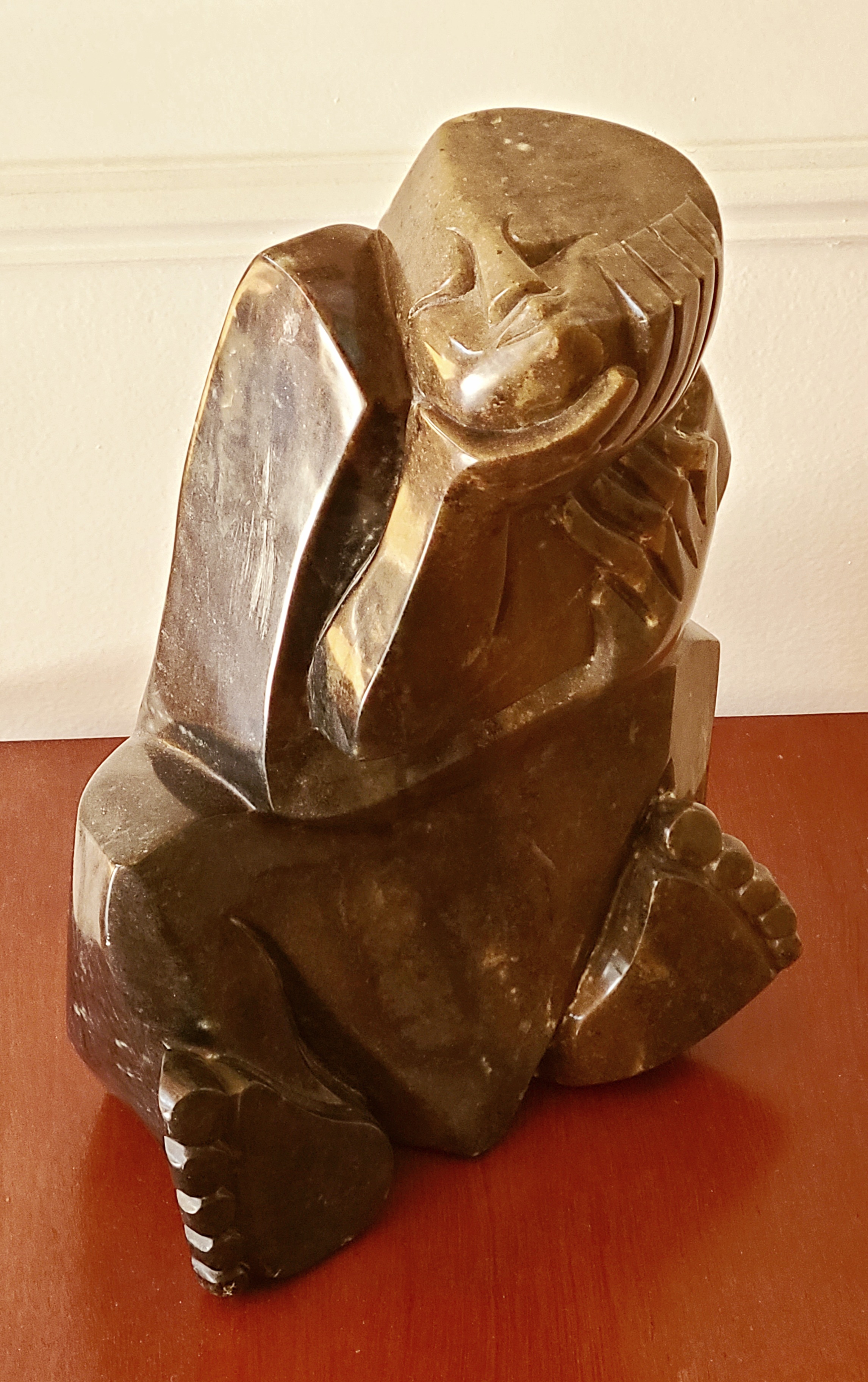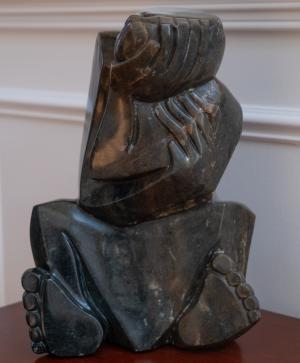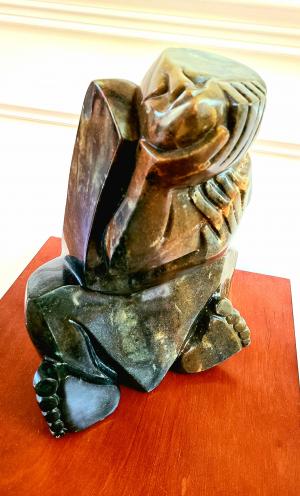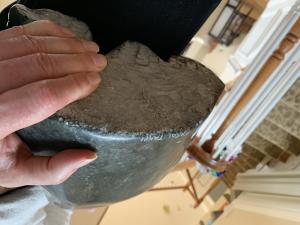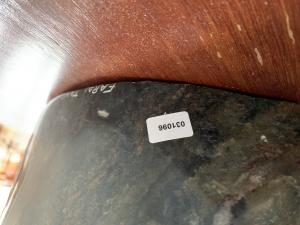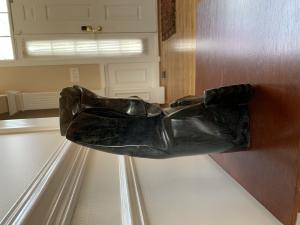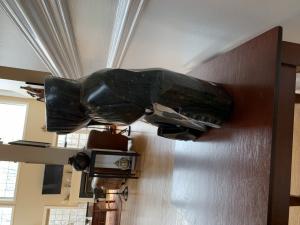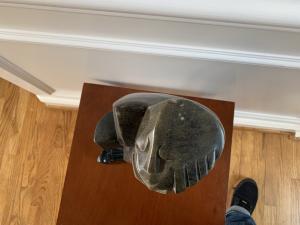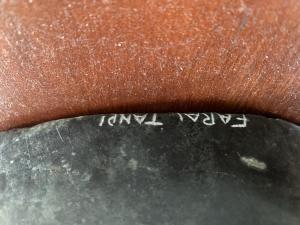Thinking about the Future
Farai Tandi
Sculpture
This springstone sculpture depicts a semi-abstract human figure sitting in contemplation, thinking, as the title suggests, about the future. Although Tandi mostly and preferably works in the fine art tradition, sculpting recognizable shapes of spiritual animals or faces of tribal members, this sculpture classifies as an abstract sculpture in the Shona tradition. As with many other abstract Shona sculptures of “humans”, these are only ambiguously so and mostly feature some identifying human visual traits, while other parts resemble more stylized features of monkeys, mostly baboons. Here, the body posture and the manner of sitting does resemble that of the monkey, but we can still see the human body - from the front, the two feet and somewhat abstracted hands, one pressed against his chest, right where the heart is, and the other supporting his head, turned up and to his right so one can only see it when looking at the sculpture from the back or the side. The eyes of the figure are closed and the face of the figure seems very calm, it does not have any of dramatized features that more expressive African sculptures do. Rather, it describes a moment of calmly taking a step back from the present (thus, symbolically closing the eyes), grounded in emotions (the hand gesture close to the heart) and in the material of the earth - the strong, stone body - and meditate on the condition of life, an important feature in Shona tribal spirituality and its artistic depictions.
*Farai Tandi’s words about his spiritual process in making this piece:
The questions in everyone's mind now is so what does the future hold? What shall it be? Will i make it? Or how will this end?
So what was happening to me during this time is, we went through a lot as a country and all the experiences made me to take time to think of what the future holds for me.
Planning to change my future for i knew my past was buried and i cant affect it anymore though it may affect me if i will not think properly about the future.
And seeing what happening around the globe you begin to think about the future.
Is there gonna be life and light?
*Farai Tandi’s words about his spiritual process in making this piece:
The questions in everyone's mind now is so what does the future hold? What shall it be? Will i make it? Or how will this end?
So what was happening to me during this time is, we went through a lot as a country and all the experiences made me to take time to think of what the future holds for me.
Planning to change my future for i knew my past was buried and i cant affect it anymore though it may affect me if i will not think properly about the future.
And seeing what happening around the globe you begin to think about the future.
Is there gonna be life and light?
Stone carving has been a part of Zimbabwean culture since the 1200s and re-emerged as a modern sculptural tradition in the 1950s, known as the “Shona movement”. The driving force behind this art renaissance was Frank McEwen, director of the Rhodesia National Gallery from 1957 to 1973. McEwen encouraged and supported aspiring artists as they started the movement that would quickly become world-renowned. International collectors and critics were amazed at the rigour, spontaneity and originality of the works coming from an area of Africa which had none of the great sculptural heritage of West Africa and had been previously described as rather barren in terms of its visual arts. Contrary to other artistic tendencies and movements coming out of Africa in the post-colonial period, Shona sculptures were not looking back at the tradition of functional sculptural objects inspired by traditional customs and rituals, rather they found their sources in the present and created sculptures that blend the contemporary moment with the memories and dreams of their tribal past - the so-called “tribal consciousness” that was thematically encouraged by McEwen, alongside more modernist expressionist tendencies. Up to today, artists, without preliminary studies, spontaneously carve out semi-abstract shapes of birds and other animal or human forms imbued with ancestral symbolism, expressing an integral part of present day Shona folklore and religious beliefs.
Height: 15
Width: 10
Depth: 5
inches
Phoenix, AZ
Harare, Zimbabwe
*Material: The sculpture is carved out of springstone, a very hard member of the serpentine stone family, all of which are locally sourced in Zimbabwe. It is a beautiful dark stone, that can be polished to a high shine because of its density and presents a much bigger challenge to sculptors than other softer varieties of serpentine. As with other stones that are mined for the purpose of sculpting, springstone is mined by hand on communal lands and mostly found in northern Zimbabwe.
*Technique: Most sculptors from Zimbabwe still use the traditional carving technique, without the use of any modern machines. As per tradition, the artist first sketches out a rough shape using charcoal and then uses a punch to strip away the extraneous rock around the sketch. Next, he uses a chasing hammer with a row of little teeth that removes more of the rough texture. Using a grinder of a file, he smooths out the surface or uses a chisel for the parts of the sculpture that a grinder can’t access. Fine details are worked out with smaller files, punch hammers and other specialized tools. Once the shaping is complete, the sculpture is washed smooth with wet and dry sandpaper. The final touch is the polishing, whereby the stone is first heated using a paraffin blowtorch or an open fire, then, layers of clear wax are applied. When the stone has cooled, the artist buffs up the waxed area with a soft cloth to create the shine and give depth of colour.
Farai Tandi was born 1986, Murehwa, Zimbabwe and has been carving stone sculpture sine the age of 10. He grew up surrounded by art - his grandfather, Gabriel Tandi, was one of the pioneers of the Shona art movement and his father, Thomas Tandi is a world renowned sculptor. Farai says carving is his life, his blood and his sixth sense. Although challenging, he mostly works with hard stones and specializes in fine art as well as more abstract sculptures. His work has been exhibited all over the world and has won notable awards, including the AGIO exhibition awards, the competition of Chitungwiza Arts Centre’s 10th Anniversary Celebration and the 2016 NAMA Award for his "Happy Elefant" sculpture.
